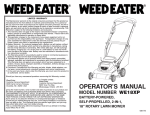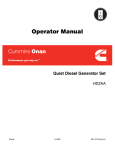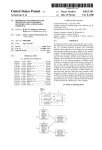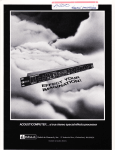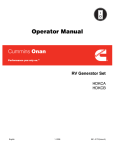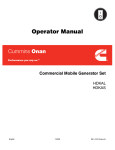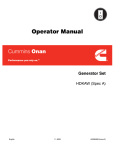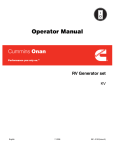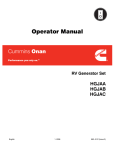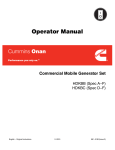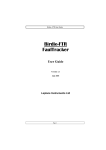Download CUMMINS P5350c Specifications
Transcript
Operator Manual Portable Generator Set EGMBD, EGMBD, EGMBD, EGMBE, EGMBE, EGMBE, EGMBE, English 12−2008 P5350ec P5350ce P5500ec P5450ec P5450ec P5550ec P6500ec 914−0103 (Issue 3) Table of Contents 1. SAFETY PRECAUTIONS ............................................................................................................... 1 1.1 Exhaust Gas Is Deadly ............................................................................................................ 1 1.2 Gasoline is Flammable / Explosive.......................................................................................... 1 1.3 Generator Voltage is Deadly.................................................................................................... 2 1.4 Moving Parts Can Cause Severe Personal Injury or Death .................................................... 2 1.5 Battery Gases Are Explosive ................................................................................................... 2 1.6 General Precautions ................................................................................................................ 2 2. INTRODUCTION............................................................................................................................. 5 2.1 About This Manual ................................................................................................................... 5 2.2 Model Identification .................................................................................................................. 5 2.3 Wheel Kit.................................................................................................................................. 9 2.4 Fuel Requirements................................................................................................................... 9 2.5 Assembly Instructions ............................................................................................................ 10 2.6 Wheel Kit Assembly Instructions ........................................................................................... 10 2.7 Engine Oil Recommendations ............................................................................................... 12 2.8 Starting Battery ...................................................................................................................... 12 3. STARTING AND RUNNING THE GENERATOR SET.................................................................. 13 3.1 Control Panel ......................................................................................................................... 13 3.2 Pre-Start Checks.................................................................................................................... 19 3.3 Starting the Generator Set..................................................................................................... 20 3.4 Stopping the Generator Set ................................................................................................... 22 3.5 Powering Tools and Appliances ............................................................................................ 23 3.6 Charging Batteries ................................................................................................................. 25 3.7 Circuit Breakers ..................................................................................................................... 25 3.8 Grounding .............................................................................................................................. 25 3.9 Low Oil Shutdown .................................................................................................................. 25 3.10 Electrical Interference with Communications or Appliances ................................................ 26 3.11 Exercising the Generator Set............................................................................................... 26 3.12 Engine Break-In ................................................................................................................... 26 3.13 Out-of-Service Protection..................................................................................................... 26 4. MAINTENANCE ............................................................................................................................ 29 4.1 Maintenance Schedule .......................................................................................................... 29 914-0103 (Issue 3) i Table of Contents 12-2008 4.2 General Inspections ............................................................................................................... 30 4.3 Changing Engine Oil .............................................................................................................. 30 4.4 Air Filter Maintenance ............................................................................................................ 31 4.5 Battery Maintenance .............................................................................................................. 32 4.6 Fuel Sediment Cup Cleaning................................................................................................. 33 4.7 Spark Plug Maintenance........................................................................................................ 33 4.8 Cleaning the Generator Set ................................................................................................... 34 4.9 Cleaning the Spark Arrester .................................................................................................. 35 5. TROUBLESHOOTING .................................................................................................................. 37 6. SPECIFICATIONS ........................................................................................................................ 41 7. IMPORTANT INFORMATION FOR CALIFORNIA USERS .......................................................... 43 ii 914-0103 (Issue 3) 1 Safety Precautions Thoroughly read the Operator Manual before operating the generator set. Safe operation and top performance can only be obtained when equipment is operated and maintained properly. The following symbols, found throughout this manual, alert you to potentially dangerous conditions to operators, service personnel, and the equipment. DANGER: This symbol alerts you to an immediate hazard that will result in severe personal injury or death. WARNING: This symbol alerts you to a hazard or unsafe practice that can result in severe personal injury or death. CAUTION: This symbol alerts you to a hazard or unsafe practice that can result in personal injury or damage to equipment or property. 1.1 Exhaust Gas Is Deadly · Operate the generator set outdoors only. Stay away from the exhaust outlet. · Make sure generator set exhaust will not enter windows, doors, vents, or air intakes of adjacent buildings, vehicles, or boats. · NEVER USE THE GENERATOR SET INSIDE a home, garage, crawl space, barn, shed, cabin, boat, boat house, RV, or tent, or in a confined outdoor space such as an alley, ditch, parking garage, or courtyard, or in any other space where exhaust can accumulate. Note that HAZARDOUS CARBON MONOXIDE LEVELS FROM ENGINE EXHAUST CAN ACCUMULATE INDOORS, EVEN WHEN ALL WINDOWS AND DOORS ARE OPEN AND FANS ARE RUNNING. · Even when you use a generator set correctly, CO may leak into the home. ALWAYS use a battery-powered or battery-backup CO alarm in the home. · If you feel sick, dizzy, or weak after the generator set has been running, move to fresh air RIGHT AWAY. See a doctor. You could have carbon monoxide poisoning. 1.2 Gasoline is Flammable / Explosive · Refuel the generator set outdoors only. 914-0103 (Issue 3) 1 1. Safety Precautions 12-2008 · Static electric sparks caused by fuel flowing through a service station pump nozzle can ignite gasoline. Never fill the generator set with a service station pump nozzle. Instead, fill a safety tank sitting on the ground and then slowly transfer fuel to the generator set from the safety tank. · DO NOT fill fuel tanks while the engine is running. A hot engine can ignite the fuel. · To prevent fire due to fuel leakage, always close the fuel valve and let the generator set cool before transporting it or storing it in a confined space. · DO NOT SMOKE OR ALLOW AN OPEN FLAME near the generator set. Keep flames, sparks, electrical switches, pilot lights, electrical arcs, arc-producing equipment, and all other sources of ignition well away. 1.3 Generator Voltage is Deadly · DO NOT CONNECT THE GENERATOR SET DIRECTLY TO ANY BUILDING ELECTRICAL SYSTEM. Back-feed could cause electrocution of utility line workers and could damage equipment. An approved switching device must be used to prevent interconnections. A trained and experienced electrician must make electrical connections when the generator set is used for emergency power. · Make sure clothing, shoes, and skin are dry when handling electrical equipment. · Never operate the generator set in rain or snow or when it is sitting on wet ground. 1.4 Moving Parts Can Cause Severe Personal Injury or Death · Before performing any maintenance on the generator set, disconnect the spark plug wire. · Always keep hands away from moving parts. · Do not wear loose clothing or jewelry while servicing the generator set. Loose clothing and jewelry can become caught in moving parts. Jewelry can short out electrical contacts causing sparks, flame and electrical shock. · Make sure that fasteners and clamps on the generator set are tight. Keep guards in position over fans, rotors, etc. 1.5 Battery Gases Are Explosive · Wear safety glasses when servicing batteries. · Do not smoke. · To reduce arcing when disconnecting or reconnecting battery cables, always disconnect the negative (–) cable of the battery first and reconnect it last. 1.6 General Precautions · Keep children away from the generator set. · Wear hearing protection when near an operating generator set. 2 914-0103 (Issue 3) 12-2008 1. Safety Precautions · Keep a multi-class ABC fire extinguisher readily at hand. Class A fires involve ordinary combustible materials, such as wood and cloth. Class B fires involve combustible and flammable liquids and gaseous fuels. Class C fires involve live electrical equipment. (ref. NFPA No. 10). · Benzene and lead may be found in gasoline and have been identified by some state and federal agencies as causing cancer or reproductive toxicity. Do not ingest, inhale, or contact gasoline. · Used engine oils have been identified by some state and federal agencies as causing cancer or reproductive toxicity. Do not ingest, inhale, or contact used engine oil or its vapors. · Keep the generator set clean and dry at all times. Excess grease and oil can catch fire and/or accumulate dirt, which can cause overheating. · Do not store anything on the generator set, such as oil cans, oily rags, chains or wooden blocks. A fire could result or operation could be adversely affected. · Do not work on the generator set when you are mentally or physically fatigued or have consumed alcohol or drugs. 914-0103 (Issue 3) 3 1. Safety Precautions 12-2008 This page is intentionally blank. 4 914-0103 (Issue 3) 2 Introduction 2.1 About This Manual This manual covers the generator sets listed on the front cover. Study this manual and observe all of its warnings and precautions. Using and maintaining the generator set properly will result in longer generator set life, better performance, and safer operation. 2.2 Model Identification Be ready to provide the generator set model and serial numbers on the generator set nameplate when contacting Cummins Onan for parts, service, or product information. The nameplate and its location on the generator set is illustrated in the Figure below. WARNING: Many troubleshooting procedures or replacement of parts present hazards that can result in equipment damage and severe personal injury or death. Only trained and experienced service personnnel with knowledge of fuels, electricity, and machinery hazards should perform service procedures. Review the Safety Precautions section of this manual. FIGURE 1. 914-0103 (Issue 3) NAMEPLATE LOCATION FOR P5350, P5350C, P5450E, P5450EC, AND P5550E GENERATOR SETS 5 2. Introduction 12-2008 FIGURE 2. 6 NAMEPLATE LOCATION FOR P5500 AND P6500 914-0103 (Issue 3) 12-2008 2. Introduction No. Description No. Description 1 Fuel Tank Cap 6 Recoil Starter Grip 2 Fuel Gauge 7 Control Panel 3 Choke Lever 8 Muffler 4 Fuel Level 9 Spark Plug Boot 5 Air Cleaner NOTE: Carb models (P5350c and P5450ec) may include additional components not shown. FIGURE 3. COMPONENT LOCATIONS (P5350, P5350C, P5450E, P5450EC, P5500, AND P5550E) 914-0103 (Issue 3) 7 2. Introduction No. 12-2008 Description Description 1 Fuel Tank Cap 6 Recoil Starter Grip 2 Fuel Gauge 7 Battery 3 Choke Lever 8 Control Panel 4 Fuel Valve 9 Muffler 5 Air Cleaner 10 Spark Plug Boot FIGURE 4. 8 No. COMPONENT LOCATIONS (P6500) 914-0103 (Issue 3) 12-2008 2.3 2. Introduction Wheel Kit The assembled wheel kit shown below is standard equipment on P5350, P5350c, P5450e, P5450ec, and P5550e models. FIGURE 5. WHEEL KIT INSTALLED 2.4 Fuel Requirements Use clean, fresh unleaded gasoline with an octane rating (anti-knock index) of 87 or higher. During part of the year, only mandated "oxygenated" gasoline may be available. While "oxygenated" gasoline is acceptable for use, it is not preferable. Using leaded gasoline will result in extra maintenance to remove combustion changer and spark plug deposits. Do not use starting fluids and do not use gasoline or gasoline additives (de-icers) containing methanol. Methanol is corrosive to fuel system components. WARNING: Evaporative starting fluids, such as ether, are highly explosive which can result in severe personal injury or death. Do not use starting fluids. CAUTION: Methanol is corrosive to fuel system components. Do not use gasoline or gasoline additives containing methanol. WARNING: Gasoline is highly flammable and explosive which can result in severe personal injury or death. Do not smoke if you smell gasoline or are near fuel tanks or gasoline-burning equipment, or are in the area sharing ventilations with such equipment. Keep flames, sparks, electrical swithces, pilot lights, arc-producing equipment,and all other sources of ignition well away from the area. 914-0103 (Issue 3) 9 2. Introduction 2.5 12-2008 Assembly Instructions 1. Remove the generator set from the box. WARNING: The generator set is heavy. Dropping the generator set can cause severe personal injury or death. Keep feet and hands clear when lifting the generator set. 2. If necessary, install the wheel kit (see the Wheel Kit Assembly Instructions). 3. Add oil to the generator set. CAUTION: Too little oil can cause severe engine damage. Make sure that the oil level is above the Add mark on the dipstick. 4. Add gasoline to the fuel tank. CAUTION: Methanol is corrosive to fuel system components. Do not use gasoline or gasoline additives containing methanol. The use of leaded gasoline will require extra maintenance. Avoid using leaded gasoline. 5. If necessary, install the battery. A 12 volt, 14L-A2 type battery is recommended. The battery is not included with the generator set. The battery cables are often tucked up behind the control panel. Connect the positive (+) cable (red) first and then the negative (–) cable (green). 2.6 Wheel Kit Assembly Instructions CAUTION: Improper handling of the generator set can result in equipment damage. Do not turn the generator set on the side, top, or end. Doing so may damage the generator set or cause dangerous fuel or oil leakage. Do not place items on top of the generator set. The wheel kit is designed to support the generator only. Required Tools · 10 and 12 mm wrenches, sockets, and ratchet · Three 6-inch high blocks of wood · Pliers Installation Procedure 1. Install the handle assembly (handle, bracket, hinge pin, grips, end plugs, two cotter pins, and fasteners). a. Use two long bolts to attach the handle assembly to the frame. b. Tighten securely; do not crush the frame tube. 2. Block up the generator set under both frame tubes as shown below. Place a block under the center of the cross-member on the exhaust end. 3. Install the leg assembly. a. Install a leg assembly (support leg, rubber pad, and fastener) onto each side of the exhaust end cross-member. b. Use two bolts and nuts for each leg and tighten securely. 10 914-0103 (Issue 3) 12-2008 2. Introduction 4. Install the wheel and axle assembly (axle assembly and wheel assemblies). a. Remove the rubber pads secured to the frame where the axle is attached. b. Remove the cotter pins and loose washers from the axle assembly (axle, two loose washers, two cotter pins, and fasteners). c. Install the wheels (flat free tire and wheel); make sure the long hub is to the inside. d. Reinstall the washers and cotter pins on the axle assembly. Bend one leg of each cotter pin. e. Place the axle assembly under the cross member as shown and install four bolts and nuts. Tighten securely. No. Description No. Description 1 Frame 4 Support Leg Assembly 2 Wheel Assembly 5 Wooden Blocks 3 Axle Assembly 6 Handle Assembly FIGURE 6. INSTALLED WHEEL KIT 914-0103 (Issue 3) 11 2. Introduction 2.7 12-2008 Engine Oil Recommendations Use American Petroleum Institute (API) performance class SL or SJ engine oil or better. Also look for Society of Automotive Engineers (SAE) viscosity grade oil (see the table below). Choose the viscosity grade appropriate for the ambient temperature expected until the next scheduled oil change. Refer to the Specifications section for engine oil capacity. Single-grade SAE 30 oil is best when temperatures are consistently above freezing. Multi-grade oils are better when wide temperature variations are expected. TABLE 1. OIL VISCOSITY VS. TEMPERATURE Expected Ambient Temperatures 30o F (0 C) and higher SAE Viscosity Grade 30 10o F to 100o F (-12o C to 38o C) 15W-40 0o F to 80o F (-18o C to 27o C) 10W-30 10W-40 -20o F to 50o F (-28o to 10o C) 5W-30 2.8 Starting Battery A starting battery is used in EGMBE models (P5550e, P5450e, P5450ec, and P6500). The electric starter requires a 12 volt starting battery (12 volt, 14L-A2). The battery is not included with the generator set. Refer to the "Maintenance" section and any instructions available from the battery manufacturer for battery maintenance. Note that as long as the generator set is run regularly, the automatic battery recharging system on the engine should maintain battery charge. 12 914-0103 (Issue 3) 3 Starting and Running the Generator Set 3.1 Control Panel The control panels are illustrated below. The control switches, meters, output receptacles, and circuit breaker reset buttons are grouped for convenient operation. No. Description No. Description 1 Start/On/Off Switch 6 One 120/240 VAC, 30A Receptacle (L14-30R) 2 DC Circuit Breaker Reset 7 Earth Ground Lug 3 Two 120 VAC, 20A Receptacles (GFCI) 8 120 VAC or 120/240 VAC Selector Switch 4 AC Circuit Breaker Reset 9 One 120 VAC, 30A Receptacle (L5-30R) 5 AC Voltmeter 10 12 Volt DC Terminals FIGURE 7. 914-0103 (Issue 3) P5550E CONTROL PANEL 13 3. Starting and Running the Generator Set No. Description 12-2008 No. Description 1 On/Off Switch 5 AC Circuit Breaker Reset 2 Earth Ground Lug 6 One 120/240 VAC 30A Receptacle (L14-30R) 3 Two 120 VAC, 20A Receptacles (GFCI) 7 Two 120 VAC, 20A Receptacles 4 AC Circuit Breaker Reset FIGURE 8. 14 P5350 CONTROL PANEL 914-0103 (Issue 3) 12-2008 No. 3. Starting and Running the Generator Set Description No. Description 1 On/Off Switch 5 AC Circuit Breaker Reset 2 Earth Ground Lug 6 One 120/240 VAC 30A Receptacle (L14-30R) 3 Two 120 VAC, 20A Receptacles (GFCI) 7 Two 120 VAC, 20A Receptacles 4 AC Circuit Breaker Reset FIGURE 9. 914-0103 (Issue 3) P5350C CONTROL PANEL 15 3. Starting and Running the Generator Set No. Description 12-2008 No. Description 1 Start/On/Off Switch 5 AC Circuit Breaker Reset 2 Earth Ground Lug 6 One 120/240 VAC 30A Receptacle (L14-30R) 3 Two 120 VAC, 20A Receptacles (GFCI) 7 Two 120 VAC, 20A Receptacles 4 AC Circuit Breaker Reset FIGURE 10. 16 P5450E CONTROL PANEL 914-0103 (Issue 3) 12-2008 No. 3. Starting and Running the Generator Set Description No. Description 1 Start/On/Off Switch 5 AC Circuit Breaker Reset 2 Earth Ground Lug 6 One 120/240 VAC 30A Receptacle (L14-30R) 3 Two 120 VAC, 20A Receptacles (GFCI) 7 Two 120 VAC, 20A Receptacles 4 AC Circuit Breaker Reset FIGURE 11. 914-0103 (Issue 3) P5450EC CONTROL PANEL 17 3. Starting and Running the Generator Set No. Description 12-2008 No. Description 1 Start/On/Off Switch 7 Two 120 VAC, 20A Receptacles (GFCI) 2 DC Breaker Reset Switch 8 One 120 VAC, 30A Receptacle (L5-30R) 3 AC Circuit Breaker Reset 9 120 VAC or 120/240 VAC Selector Switch 4 AC Voltmeter 10 One 120/240 VAC, 30A Receptacle (L14-30R) 5 AC Circuit Breaker Reset 11 Earth Ground Lug 6 12 Volt DC Terminals FIGURE 12. 18 P5500 AND P6500 CONTROL PANEL 914-0103 (Issue 3) 12-2008 3.2 3. Starting and Running the Generator Set Pre-Start Checks DANGER: EXHAUST GAS IS DEADLY! THE INDOOR USE OF A GENERATOR SET CAN KILL QUICKLY. Exhaust gases contain carbon monoxide, an odorless and colorless gas. Carbon monoxide is poisonous and can cause unconsciousness, severe personal injury, and death. Symptoms of carbon monoxide poisoning include: · Dizziness · Nausea · Headache · Weakness and sleepiness · Throbbing in temples · Muscular twitching · Vomiting · Inability to think coherently IF YOU OR ANYONE ELSE EXPERIENCE ANY OF THESE SYMPTOMS, GET INTO FRESH AIR IMMEDIATELY. Then: · Seek immediate advice from poison control, medical center, or 911. Be aware that: · CO symptoms can be mistaken for flu, dehydration, food poisoning, or other illness. · Injury or death can occur later when in fresh air and apparently recovering. · Call the fire department to determine when it is safe to re-enter the area. Operate the generator set OUTDOORS only. Stay away from and upwind of the exhaust outlet. Make sure the exhaust will not enter windows, doors, vents, or air intakes of adjacent buildings, vehicles, or boats. Never use the generator set inside a home, garage, crawl space, barn, shed, cabin, boat, boat house, RV, or tent; or in a confined outdoor space such as an alley, ditch, parking garage, or courtyard, or in any other space where exhaust can accumulate. Hazardous carbon monoxide levels from generator set exhaust can accumulate indoors even when windows and doors are open and fans are running. Even when you use a generator set correctly, CO may leak into the home. ALWAYS use a battery-powered or battery-backup CO alarm in the home. If you feel sick, dizzy, or weak after the generator set has been running, move to fresh air RIGHT AWAY. See a doctor. You could have carbon monoxide poisoning. 914-0103 (Issue 3) 19 3. Starting and Running the Generator Set 12-2008 Before the first start of the day and after every eight hours of operation, perform GENERAL INSPECTIONS and any scheduled maintenance due, as indicated in the Periodic Maintenance Schedule. If the generator set has been in storage, return it to service as instructed in the "Out-of-Service Protection" section. WARNING: Moving parts can cause severe personal injury or death. Hot exhaust parts can cause severe burns. Make sure all protective guards are properly in place before starting the generator set. A non-functioning GFCI, or a damaged or overloaded extension cord, can cause electrocution or fire. Test the GFCI for proper operation. Make sure all extension cords are in good condition, are rated for outdoor use, have the proper plugs, and have the proper amp and voltage ratings. WARNING: Gasoline is highly flammable and expolsive and can be ignited by static electric sparks caused by fuel flowing through a service station pump nozzle which can result in severe personal injury or death. Never fill the generator set with a service station pump nozzle. Instead, fill a safety tank sitting on the ground and then slowly transfer fuel to the generator set from the safety tank. 1. Locate the generator set outdoors in a dry, level place and chock the wheels, if so equipped. 2. Check fuel and oil levels, and fill as necessary. WARNING: If the generator neutral supply is not grounded to earth, the user may be left without ground fault protection, which could result is serious personal injury or death. Always make sure the generator neutral supply is grounded to earth before operating the generator set. 3. Connect the grounding lug to earth ground in accordance with the local electrical code. 4. Test the GFCI for proper operation. 5. Make sure that all extension cords are in good condition, are rated for outdoor use and have the proper amp and voltage ratings, and that they are equipped with proper plugs having grounding blades. 6. Make sure all tools and appliances have been turned off or disconnected. 3.3 Starting the Generator Set WARNING: Operating a generator set in an inappropriate environment can result in a fire which can result in severe personal injury or death. Do not operate the generator set in hazardous environments where it could ignite flammable gasses or combustible materials. 20 914-0103 (Issue 3) 12-2008 3. Starting and Running the Generator Set To avoid the risk of electrocution, never operate the generator set in rain or snow or when it is sitting on wet ground. Be careful not to touch or allow any combustible materials to touch the muffler which can get very hot. CAUTION: The voltage surge at startup can damage appliances such as TVs, microwave ovens, computers, etc. Be sure to disconnect all appliances before starting the generator set. 3.3.1 Using the Electric Starter An electric starter is available on EGMBE models (P5550e, P5450e, P5450ec, and P6500). To use the electric starter, 1. Open the fuel valve. 2. Pull the choke rod out to close the choke if the engine is cold. 3. Press and hold the Start/On/Off switch in the START position until the engine starts. The switch will return to the ON position when released. Gradually push the choke rod in as the engine warms up. 4. Let the engine warm up for a few minutes before connecting tools or appliances. See "Powering Tools and Appliances." 3.3.2 Using the Recoil Starter 1. Open the fuel valve (see Figure 13). 2. Pull the choke rod out to close the choke if the engine is cold (see Figure 14). 3. Verify that the On/Off switch is in the ON position. 4. With one hand on the generator, grip the recoil handle with the other hand and pull it out quickly and smoothly. Repeat as necessary until the engine starts (see Figure 15). 5. As the engine warms up, gradually push the choke rod in. 6. Let the engine warm up for a few minutes before connecting tools or appliances. See "Power Tools and Appliances." FIGURE 13. 914-0103 (Issue 3) FUEL VALVE 21 3. Starting and Running the Generator Set No. 12-2008 Description 1 Choke Lever 2 Open No. 3 FIGURE 14. FIGURE 15. 3.4 Description Close CHOKE ROD RECOIL START HANDLE Stopping the Generator Set 1. Turn off or disconnect all tools and appliances. 2. Let the generator set run for a few minutes to cool down. 3. Stop the generator set by pressing and holding the On/Off switch in the Off position until the generator set stops. 4. Close the fuel valve. WARNING: Gasoline is highly flammable and explosive which can result is severe personal injury or death. Always close the fuel valve when the engine is not in use to reduce the risk of fuel spillage. 22 914-0103 (Issue 3) 12-2008 3. Starting and Running the Generator Set 3.5 Powering Tools and Appliances CAUTION: Continuous overloading can damage the generator set due to overheating. Make sure loading is within the generator set nameplate rating. 3.5.1 Voltage Selector Switch An AC voltage selector switch is available on P5550e, P5500, and P6500 portable generator sets. To Power 120/240 Volt AC Circuits: Push the voltage selector switch on the control panel towards the 120/240 Volt output receptacle. Power will also be available at the 120 Volt AC receptacles. The voltmeter on the control panel will indicate approximately 240 Volts AC when the generator set is running. To Power 120 Volt AC Circuits Only: Push the voltage selector switch on the control panel towards the 120 Volt output receptacles. The voltmeter on the control panel will indicate approximately 120 Volts AC when the generator set is running. 3.5.2 Connecting Tools and Appliances TABLE 2. TYPICAL POWER DRAW RATINGS OF COMMON TOOLS AND APPLIANCES Appliance or Tool Ceiling Fan Running Watts (Rated)1 Starting Watts (Peak)1 800 1200 2 1500 3000 2 Central Air Conditioner - 24,000 BTU 3800 4950 Circular Saw - 7¼" 1400 2300 Clock Radio 100 - Clothes Dryer - Gas 700 1200 Coffee Maker 1500 - Computer - 17" Monitor 800 - Deep Freezer 700 1000 Dishwasher 1500 1500 Electric Water Heater - 40 Gallon2 4000 - Furnace Fan 800 1300 Garager Door Opener 750 1200 Hair Dryer 1250 - Hot Plate 2100 - Iron 1200 - Laser Printer 9500 - 75 - Microwave Oven 1000 - Miter Saw - 10" 1650 2400 Central Air Conditioner - 10,000 BTU Lighting 914-0103 (Issue 3) 23 3. Starting and Running the Generator Set 12-2008 Oscillating Fan 200 400 Quartz Halogen Work Light 1000 - Reciprocating Saw 1200 2000 Refrigerator/Freezer 700 1500 Security System 500 - Space Heater 1800 - Stereo Receiver 450 - Sump Pump 800 1200 Table Fan - 14" 200 400 Television - 27" 500 - 100 - Water Well Pump - 1/3 HP (220V) 1000 2000 Window Air Conditioner - 10,000 BTU 1200 2200 2 VCR/DVD Player 2 1 The wattage values listed in this table are based on estimated wattage requirements. For exact wattage, check the data plate or the operator's manual for the item you wish to power. 2 These units are usually hard-wired and require a professionally-installed transfer switch. NOTE: Ratings apply to altitudes up to 1000 feet (304.8 m), 85oF (30oC). Total power available will decrease 3.5% for each 1000 feet (304.8 m) above 1000 feet and 2.0% for each 10oF (5.5oC) increase in ambient temperature above 85oF (30oC). 1. Make sure the tools and appliances to be connected are rated for the voltages at the generator set power out put receptacles. 2. Note the kW rating on the generator set nameplate. 3. Check the power draw (watts) of each tool or appliance to be connected. Table 2 lists typical tool and appliance ratings in watts. 4. Add the watt ratings of all the loads that the generator set will be powering at the same time. Make sure that total wattage will not exceed the generator kW rating. Example: A generator set rated 5 kW (5000 watts) can power two 1500 watt heaters, a 900 watt circular saw, a 500 watt drill, and a 100 watt light at the same time (4500 watts altogether). However, to operate a second 900 watt saw, it will be necessary to disconnect one of the 1500 watt heaters. CAUTION: Excessive power draw can overload the generator set. A motor draws much more power when starting up than when running. It may be necessary to power fewer tools or appliances when motors and air conditioners are cycling on and off. 5. Connect the AC power cords to the appropriate receptacles on the control panel. See "Grounding." 3.5.3 High Altitude Maximum power decreases roughly four percent every 1000 feet (310 m) of increase in elevation above sea level. When operating the generator set at altitudes above 1000 feet, it may be necessary to power fewer loads at the same time. 24 914-0103 (Issue 3) 12-2008 3.6 3. Starting and Running the Generator Set Charging Batteries To reduce arcing, always stop the generator set before connecting or disconnecting the battery to be charged. Connect the battery to be charged to the DC terminals on the control panel. Make sure polarity is correct: positive (+) to positive (+); negative (–) to negative (–). WARNING: Ignition of explosive battery gases can cause severe personal injury or death. Acring at battery terminals can ignite batterey gases. Ventilate the area before working on batteries. Wear safety glasses and do not smoke. Always stop the generator set before disconnecting the battery. Always disconnect the negative (–) cable first and reconnect it last. NOTE: 3.7 The battery on electric-start models has its own charging circuit and therefore must not be connected to the DC charging terminals. Circuit Breakers If too many tools or appliances are connected, or a tool or appliance fails due to a short circuit, one or more of the AC or DC circuit breakers on the control panel will trip. Disconnect or turn off as many tools and appliances as possible and reset the circuit breaker by pushing the reset button back in. (It takes at least 10 seconds after tripping to reset.) Turn on or reconnect only as many tools and appliances as the generator set can power. A tool or appliance probably has a short if it causes a circuit breaker to immediately trip when connected. WARNING: Short circuits in faulty electrical tools and appliances can cause electrocution or fire. Read and follow the tool and appliance manufactuer's instructions and warnings regarding use, maintenance, and proper grounding. 3.8 Grounding Ground the generator set to earth ground by connecting a suitable ground wire to the ground lug terminal on the generator set control panel. The other end of the wire must be connected to a suitable earth ground according to local electrical codes. Do not connect grounds from tools or appliances to the Ground Lug terminal. Extension cords for tools or appliances with grounding blades must have grounding blades. WARNING: If the generator neutral supply is not grounded to earth, the user may be left without ground fault protection, which could result in serious personal injury or death. Always make sure the generator neutral supply is grounded to earth before operating the generator set. 3.9 Low Oil Shutdown The generator set automatically stops if it senses low oil level. If the engine stops while running, or starts but then stops, check the oil level and add oil as necessary. See "Maintenance." 914-0103 (Issue 3) 25 3. Starting and Running the Generator Set 3.10 12-2008 Electrical Interference with Communications or Appliances If the generator set causes electrical interference with communications devices, move the generator set and device farther apart or shut down the generator set while the device is operating. 3.11 Exercising the Generator Set Exercise the generator set at least two hours every month if use is infrequent. Run it at approximately 50 percent capacity. A single two-hour exercise period is better than several shorter periods. Exercising a generator set drives off moisture, re-lubricates the engine, replaces stale fuel, and removes oxides from electrical contacts. The result is better starting, more reliable operation, and longer engine life. 3.12 Engine Break-In Proper engine break-in is necessary for top performance. 1. Operate the generator set as it is intended to be operated. However, for the first 1-1/2 hours, if possible, run the generator set at 50 percent capacity, occasionally operating at full power for brief periods. Avoid prolonged low-power operation during break-in. 2. Make sure the engine has oil of the proper viscosity for the ambient temperature. See "RECOMMENDED ENGINE OIL." 3. Check the oil level twice a day or after every 4 hours of operation during the first 20 hours of operation. Change the engine oil after the first 20 hours of operation. 3.13 Out-of-Service Protection If you are unable to exercise the generator set regularly, and it will not be in use for more than 120 days, the following storage procedure is recommended. Failure to provide out-of-service protection can result in difficult starting, rough engine operation and reduced engine life. 3.13.1 Storing the Generator Set WARNING: Fuel additives can cause a risk of personal injury. Read and follow the manufacturer's instructions. 26 914-0103 (Issue 3) 12-2008 3. Starting and Running the Generator Set No. 1 Description Fuel Drain Bolt FIGURE 16. CARBURETOR DRAIN 1. Add a fuel preservative and stabilizer to the fuel tank, or let the generator set run out of fuel. Follow the manufacturer’s instructions for using the fuel additive. 2. Shut the fuel valve and drain the carburetor bowl. See the figure above. 3. Remove the spark plug. Squirt one tablespoon (about 1 ounce / 30 cm3) of clean engine oil into the spark plug hole. Turn the engine over several revolutions. Replace the spark plug. Pull the recoil starter handle out slowly until compression is felt. 4. Change engine oil and attach a tag indicating the viscosity of oil used. 5. Disconnect the cables from the starting battery, negative (–) cable first. Store the battery in accordance with the battery manufacturer's recommendations. 6. Store the generator set in a dry, protected area. 3.13.2 Returning the Generator Set to Service 1. Check the tag on generator set to verify that oil viscosity is correct for the current ambient temperature. Add or change oil as necessary. 2. Reconnect the starting battery, neagative (–) cable last. 3. Clean the air cleaner if dirty. 4. Open the fuel valve. 5. Start the generator set. Initial start-up may be rough and smoky due to the extra oil in the cylinder. Remove and clean the spark plug if necessary. 914-0103 (Issue 3) 27 3. Starting and Running the Generator Set 12-2008 This page is intentionally blank. 28 914-0103 (Issue 3) 4 Maintenance 4.1 Maintenance Schedule Periodic maintenance is essential for top performance. Use the Table below as a guide. Under hot or dusty operating conditions some maintenance operations should be performed more frequently, as indicated by the footnotes in the table. Keep a log of maintenance performed and the hours run. Recording maintenance will help you keep it regular and provide a basis for supporting warranty claims. WARNING: Contact with a hot generator set can cause severe burns. Always allow the generator set to cool before performing any maintenance or service. WARNING: Accidental starting of the generator set during maintenance can cause severe personal injury or death. Before performing maintenance, disconnect the spark plug wire from the spark plug. For electric start models, disconnect both of the generator set starting battery cables. To reduce the risk of arcing, remove the negative (–) cable first and reconnect it last. TABLE 3. PERIODIC MAINTENANCE SCHEDULE SERVICE INTERVAL SERVICE THESE ITEMS EACH USE General Inspection x1 Check Oil Level x Test GFCI x Change Engine Oil AFTER FIRST MONTH / 20 HOURS EVERY 3 MONTHS / 50 HOURS EVERY 6 MONTHS / 100 HOURS x EVERY YEAR / 300 HOURS x 2 Clean Air Cleaner x Clean Cylinder Cooling Fins x2 Check Starting Battery (if equipped) EVERY MONTH x Clean Spark Plug x Clean the Spark Arrestor x Clean Fuel Sediment Cup x3 Clean Fuel Tank x3 Adjust Valve Clearance x3 Check fuel line Every 2 years (Replace if necessary) 3 1 See "General Inspections." Service more frequently when used in dusty envioronments. 3 These items must be performed by a trained and experienced mechanic (A list of authorized Cummins Onan dealers is available at www.cumminsonan.com). 2 914-0103 (Issue 3) 29 4. Maintenance 4.2 12-2008 General Inspections The operator should check the following before the first start of the day and after every eight hours of operation: 1. Look for fuel leaks around the fuel tank, fuel hose, fuel valve, and carburetor. Close the fuel valve and repair leaks immediately. 2. Look and listen for exhaust leaks while the engine is running. Have all leaks repaired before continuing operation. WARNING: Contact with a hot generator set can cause severe burns. Always allow the generator set to cool before perofrming any maintenance or service. 3. Check for dirt and debris and clean as necessary. CAUTION: A clogged flywheel air inlet screen or dirty cooling fins can cause overheating and engine damage. Keep the cooling fins and air inclet screen clean. 4. Check the engine oil level and add oil as necessary. See "Changing Engine Oil." 4.3 Changing Engine Oil WARNING: State and federal agencies have determined that contact with used engine oil can cause cancer and reproductive toxicity. Avoid skin contact and breathing of vapors. Use rubber gloves and wash exposed skin. Refer to the Periodic Maintenance Schedule Table in the "Maintenance Schedule" section for scheduled oil changes and the figure below. 1. Make sure the generator set is level and has been run until warm. WARNING: Crankcase pressure can blow hot engine oil out of the fill opening, causing severe burns. Always stop the generator set before removing the oil fill cap. 2. Stop the generator set and remove the oil fill cap. 3. Remove the oil drain plug and drain the oil into a pan. 4. Reinstall the drain plug and refill with new engine oil just to the brim of the fill opening. Use the oil fill tube provided with the generator to fill oil. See "Engine Oil Recommendations" for the type of engine oil to use and "Specifications" for engine oil capacity. CAUTION: Too little oil can cause severe engine damage. Make sure that the oil level is above the Add mark on the dipstick. 5. Start the generator set and let it run for a short time while checking for oil leaks. 6. Used oil is harmful to the environment. Pour the used oil into a sealed container and deliver it to the nearest recycling center. 30 914-0103 (Issue 3) 12-2008 4. Maintenance No. Description No. Description 1 Oil Filler Cap 4 Upper Level 2 Oil Drain Bolt 5 Lower Level 3 Oil Fill Tube FIGURE 17. 4.4 OIL CHECK, FILL, AND DRAIN Air Filter Maintenance Refer to the "Maintenance Schedule" section for scheduled air filter maintenance. Clean more often in dusty environments. 1. Remove the filter cover by unsnapping the two spring clips. 2. Remove the two foam filter elements and thoroughly wash them with soap and water. Let them dry thoroughly. 3. Knead in 1 teaspoon (5 cm3) of clean engine oil into each foam filter element. The oil should be distributed evenly throughout each filter element. 4. Reinstall the filter elements, the gray filter first (finer pores), and then the black filter (larger pores). 5. Secure the cover with the spring clips. 914-0103 (Issue 3) 31 4. Maintenance No. 12-2008 Description 1 Clip 2 Air Cleaner Cover No. 3 FIGURE 18. 4.5 Description Air Cleaner Element AIR CLEANER Battery Maintenance Refer to the Periodic Maintenance Schedule table for scheduled battery maintenance. Carefully follow the battery manufacturer's instrucitons. WARNING: Ignition of explosive battery gases can cause severe personal injury or death. Arcing at battery terminals can ignite battery gases. Ventilate the area before working on batteries. Wear safety glasses and do not smoke. Always stop the generator set before disconnecting the battery. Always disconnect the negative (–) cable first and reconnect it last. 1. Keep the battery case clean and dry and the teminals tight. 2. Connect the Red starter cable (+) to the positive (+) terminal of the battery and the Green cable to the negative terminal. Always disconnect the Green cable (–) first and reconnect it last. 3. Make sure the battery is securely clamped in place in its mounting bracket. CAUTION: If the generator set will be used before a starting battery is installed, insulate the red battery cable terminal with electrical insulating tape to prevent short circuits that can damage the battery charging system. 32 914-0103 (Issue 3) 12-2008 4. Maintenance FIGURE 19. 4.6 BATTERY MOUNTING Fuel Sediment Cup Cleaning Refer to the "Maintenance Schedule" section for scheduled cleaning. Have the filter replaced if the fuel has been contaminated or the engine seems to have lost power. Cleaning and replacement must only be performed by an authorized Cummins Onan dealer. 4.7 Spark Plug Maintenance Refer to the "Maintenance Schedule" section for scheduled spark plug maintenance. Perform spark plug maintenance sooner if engine performance has deteriorated. To ensure proper engine operation, the spark plug must be properly gapped and free of deposits. A fouled spark plug can cause the engine to misfire, operate erratically or stop running when a load is applied. No. 1 Description No. Removed Spark Plug Boot 2 FIGURE 20. 914-0103 (Issue 3) Description Plug Wrench SPARK PLUG 33 4. Maintenance 12-2008 WARNING: Contact with hot generator parts can cause severe burns. Always allow the generator set to cool before performing any maintenance or service. 1. Turn off the generator set and allow it to cool down. 2. Remove the spark plug cap. 3. Clean any dirt from around the spark plug base. 4. Use the wrench supplied in the tool kit to remove the spark plug. 5. Visually inspect the spark plug. Discard it if the insulator is cracked or chipped. If the spark plug is to be reused, clean it with a wire brush. 6. Measure the plug gap with a feeler gauge. Correct as necessary by carefully bending the side electrode. The cap should be 0.70-0.80mm (0.028-0.031 inch). 7. Verify that that the spark plug washer is in good condition Thread the spark plug in by hand to prevent cross-threading. 8. After the spark plug is seated, tighten with a spark plug wrench to compress the washer. If installing a new spark plug, tighten 1/2 turn after the spark plug seats to compress the washer. If reinstalling a used spark plug, tighten 1/8-1/4 turn after the spark plug seats to compress the washer. No. 1 Description Side Electrode 2 FIGURE 21. 4.8 No. Description Metal Brush SPARK PLUG MAINTENANCE Cleaning the Generator Set Refer to the "Maintenance Schedule" section for scheduled cleaning of the generator set. Clean more often in dusty environments. Remove spilled oil and fuel from the generator set immediately with a dry rag. Dispose of cleaning rags properly. Use a damp cloth to clean dust and dirt from the generator set. Do not use cleaning solvents, which can damage electrical components. WARNING: Wear safety glasses to protect your eyes from flying debris when cleaning the generator set with compressed air. 34 914-0103 (Issue 3) 12-2008 4. Maintenance CAUTION: Cleaning the generator set with a pressure washer can cause damage to the generator set by shorting the generator and other electrical components. Do not use a pressure washer to clean the generator set. Wear safety glasses if it is necessary to use compressed air to clean the engine cooling fins. Do not use a pressure washer to clean the generator set. Water can enter the generator and other electrical components causing shorts that can disable the generator set. Refer to the "Maintenance Schedule" section for scheduled spark arrester cleaning. After letting the generator set cool down, remove the spark arrestor screen. Inspect for damage and replace if defective. To clean, lightly tap the screen and clean any deposits with a wire brush. 4.9 Cleaning the Spark Arrester WARNING: Contact with a hot muffler can cause severe burns. Allow the generator set to cool before servicing the muffler. Refer to the "Maintenance Schedule" section for scheduled spark arrester cleaning. After letting the generator set cool down, remove the spark arrester screen. Inspect for damage and replace if defective. Clean any deposits on the screen with a wire brush. Reinstall the spark arrester and tighten the screw securely. No. 1 Description Spark Arrestor FIGURE 22. SPARK ARRESTOR 914-0103 (Issue 3) 35 4. Maintenance 12-2008 This page is intentionally blank. 36 914-0103 (Issue 3) 5 Troubleshooting The following troubleshooting guide can be used for basic problem diagnosis. If these recommendations do not resolve the problem, contact an authorized Cummins Onan service center. WARNING: Many troubleshooting procedures or replacement of parts present hazards that can result in equipment damage and severe personal injury or death. Only trained and experienced service personnel with knowledge of fuels, electricity, and machinery hazards should perform service procedures. Review the Safety Precautions section of this manual. WARNING: Contact with a hot generator set can cause severe burns. Always allow the generator set to cool before performing any maintenance or service. ENGINE DOES NOT CRANK (ELECTRIC START) Logic: The engine will not crank. Possible Causes: · Low battery · Bad battery connection Corrective Action: 1. Service the battery if necessary. 2. Clean and tighten battery connections. ----ENGINE CRANKS SLOWLY (ELECTRIC START) Logic: The engine cranks slowly. Possible Causes: · Low battery · Bad battery connection · Engine oil is too heavy · Load is connected Corrective Action: 1. Service the battery if necessary. 2. Clean and tighten battery connections. 3. Check the engine oil and, if too heavy, replace with recommended oil. 4. Disconnect the load before starting. 914-0103 (Issue 3) 37 5. Troubleshooting 12-2008 WARNING: Many troubleshooting procedures or replacement of parts present hazards that can result in equipment damage and severe personal injury or death. Only trained and experienced service personnel with knowledge of fuels, electricity, and machinery hazards should perform service procedures. Review the Safety Precautions section of this manual. WARNING: Contact with a hot generator set can cause severe burns. Always allow the generator set to cool before performing any maintenance or service. ENGINE WON'T START Logic: The generator set will not start. Possible Causes: · Out of fuel · Fuel value closed · Loose spark plug cable · Defective spark plug · Low oil level Corrective Action: 1. Make sure the fuel tank is full. 2. Make sure the fuel valve is fully open. 3. Make sure the spark plug cable is connected. 4. Remove and clean the spark plug; replace it if necessary. 5. Check the oil level and add oil as necessary. ----BLACK EXHAUST Logic: The exhaust is dark. Possible Causes: · Choke stuck in the closed position · Dirty air cleaner · Rich fuel mixture Corrective Action: 1. Make sure the choke is open. 2. Clean the air cleaner. 3. If the problem is still not corrected, contact a Cummins Onan service center for information on fuel mixtures. 38 914-0103 (Issue 3) 12-2008 5. Troubleshooting WARNING: Many troubleshooting procedures or replacement of parts present hazards that can result in equipment damage and severe personal injury or death. Only trained and experienced service personnel with knowledge of fuels, electricity, and machinery hazards should perform service procedures. Review the Safety Precautions section of this manual. WARNING: Contact with a hot generator set can cause severe burns. Always allow the generator set to cool before performing any maintenance or service. ENGINE STOPS Logic: The generator set stops on its own. Possible Causes: · Out of fuel · Low oil level Corrective Action: 1. Make sure the fuel tank is full. 2. Check the oil level and add oil as necessary. ----ENGINE SURGES Logic: The engine suddenly runs faster than normal. Possible Causes: · Loose spark plug cable · Faulty spark plug · Generator set not level · Dirty fuel strainer Corrective Action: 1. Make sure the spark plug cable is properly connected or have it serviced, if damaged. 2. Remove and clean or replace the spark plug. 3. Make sure the generator set is on a level surface. 4. Check the fuel strainer and clean if necesary. ----NO AC OUTPUT Logic: The generator set is running but you are not able to operate any tools or appliances. Possible Causes: · Tripped AC circuit breaker Corrective Action: 1. Remove all loads. 2. Reset the circuit breaker. 3. Check loads for defects and make sure the total load does not exceed the generator set rating. 914-0103 (Issue 3) 39 5. Troubleshooting 12-2008 WARNING: Many troubleshooting procedures or replacement of parts present hazards that can result in equipment damage and severe personal injury or death. Only trained and experienced service personnel with knowledge of fuels, electricity, and machinery hazards should perform service procedures. Review the Safety Precautions section of this manual. WARNING: Contact with a hot generator set can cause severe burns. Always allow the generator set to cool before performing any maintenance or service. NO DC OUTPUT Logic: The engine will not crank. Possible Causes: · Tripped DC circuit breaker Corrective Action: 1. Disconnect the battery. 2. Reset the circuit breaker. 3. Have the battery tested for shorts and, if necessary, replace the battery. 40 914-0103 (Issue 3) 6 Specifications TABLE 4. SPECIFICATIONS FOR P5350 AND P5350C (EGMBD) P5550E, P5450E, AND P5450EC (EGMBE) P5350 and P5350c (EGMBD) P5550e (EGMBE) P5450e and P5450ec (EGMBE) 60 Hz 60 Hz 60 Hz 120 / 240 Volts 120 / 240 Volts 120 / 240 Volts Rated Power 5000 Watts 5000 Watts 5000 Watts Max. Output 5300 Watts 5500 Watts 5400 Watts 41.7 / 20.9 Amps 41.7 / 20.9 Amps 41.7 / 20.9 Amps 12 VDC / 8.3 Amps 12 VDC / 8.3 Amps 12 VDC / 8.3 Amps 3600 3600 3600 Gasoline Gasoline Gasoline 1.16 US qt (1.1 L) 1.16 US qt (1.1 L) 1.16 US qt (1.1 L) Spark Plug Type F7RTC F7RTC F7RTC Spark Plug Gap 0.028 in. (0.7 mm) 0.028 in. (0.7 mm) 0.028 in. (0.7 mm) 0.0039 / 0.006 inches (0.10 / 0.15 mm) 0.0039 / 0.006 inches (0.10 / 0.15 mm) 0.0039 / 0.006 inches (0.10 / 0.15 mm) 25o BTDC 25o BTDC 25o BTDC Starting System Recoil Electric Start (Recoil Back-up) Electric Start (Recoil Back-up) Displacement 389 cc 389 cc 389 cc 181 lb (80 kg) 185 lb (83.9 kg) 182 lb (83 kg) Length 26.6 inches (675 mm) 26.6 inches (675 mm) 26.6 inches (675 mm) Width 21.2 inches (540 mm) 21.2 inches (540 mm) 21.2 inches (540 mm) Height 21.3 inches (542 mm) 21.3 inches (542 mm) 21.3 inches (542 mm) 6.5 US Gal (24.6L) 6.5 US Gal (24.6L) 6.5 US Gal (24.6L) 8.3 Hours 8.5 Hours 8.5 Hours - 12 Volt, Type 14L-42 12 Volt, Type 14L-42 GENERATOR AC OUTPUT: Frequency (Hertz) Voltage Rated Current DC OUTPUT: ENGINE Engine Speed (RPM) Fuel Engine Oil Capacity* Engine Valve Lash (Intake / Exhaust) Ignition Timing (Fixed) GENERATOR SET Dry Weight Dimensions: Fuel Tank Capacity Operating Time at Rated Output Starting Battery Requirements * See "Engine Oil Recommendations" for recommended engine oil type. 914-0103 (Issue 3) 41 6. Specifications TABLE 5. 12-2008 SPECIFICATIONS FOR P5500 (EGMBD) AND P6500 (EGMBE) GENERATOR P5500 (EGMBD) P6500 (EGMBE) 60 Hz 60 Hz 120 / 240 Volts 120 / 240 Volts Rated Power 4000 Watts 5000 Watts Rated Current 33.3 / 16.7 Amps 41.6 / 20.8 Amps 12 VDC / 8.3 Amps 12 VDC / 8.3 Amps AC OUTPUT: Frequency (Hertz) Voltage DC OUTPUT: ENGINE Engine Type Single Cylinder, Forced Air Cooling, 4-Stroke Engine Speed (RPM) 3600 3600 Gasoline Gasoline 1.16 US qt (1.1 L) 1.16 US qt (1.1 L) Spark Plug Type F7RTC F7RTC Spark Plug Gap 0.028 in. (0.7 mm) 0.028 in. (0.7 mm) 0.0039 /0.006 inches (0.10 / 0.15 mm) 0.0039 /0.006 inches (0.10 / 0.15 mm) 25o BTDC 25o BTDC Starting System Recoil Electric / Recoil Displacement 389 cc 389 cc 176 lb ( 80 kg) 182 lb ( 83 kg) Length 26.6 inches (675 mm) 26.6 inches (675 mm) Width 21.2 inches (540 mm) 21.2 inches (540 mm) Height 21.3 inches (542 mm) 21.3 inches (542 mm) 6.5 US Gal (24.6 L) 6.5 US Gal (24.6 L) 10 Hours 9 Hours - 12 Volt, Type 14L-A2 Fuel Engine Oil Capacity* Engine Valve Lash (Intake / Exhaust) Ignition Timing (fixed) GENERATOR SET Dry Weight Dimensions: Fuel Tank Capacity Operating Time at Rated Output Starting Battery Requirements * See "Engine Oil Recommendations" for recommended engine oil type. 42 914-0103 (Issue 3) 7 Important Information for California Users NOTE: This section applies to P5350C and P5450ec models. It also applies to P5500 and P6500 models built before 2008. These generator sets meet the requirements of California’s Exhaust Emissions Standards for Utility and Lawn and Garden Equipment Engines, which correspond to the engine class, the year manufactured, and the date of the original sale, if equipped with an emissions label so stating. As a California user of this engine, please be aware that unauthorized modifications or replacement of fuel, exhaust, air intake, or speed control system components that affect engine emissions are prohibited. Unauthorized modification, removal, or replacement of the engine label is prohibited. Carefully review this Operator Manual along with any other manuals and information you received with your generator set. If you are unsure that the installation, use, maintenance, or service of your generator set is authorized, seek assistance from an approved Cummins Onan engine dealer or an approved dealer for your equipment. California engine users may use the information below as an aid in locating information related to the California Air Resources Board requirements for emissions control. TABLE 6. EMISSIONS CONTROL INFORMATION Engine Warranty Information The California emissions control warranty statement is located in the same packet of information as this manual when the engine is shipped from the factory. Engine Valve Lash See "Specifications." Engine Ignition Timing See "Specifications." Engine Fuel Requirements The engine is certified to operate on unleaded gasoline. See Fuel Recommendations in "Introduction." Engine Lubricating Oil Requirements See Engine Oil Recommendations in "Introduction." Engine Fuel Mixture Settings These engines have precision–manufactured carburetors which are not adjustable. Engine Adjustments See "Starting and Running the Generator Set." Engine Emission Control System The engine emission control system consists of internal engine design and construction. 914-0103 (Issue 3) 43 7. Important Information for California Users 12-2008 This page is intentionally blank. 44 914-0103 (Issue 3) Cummins Power Generation 1400 73rd Ave. NE Minneapolis, MN 55432 USA Phone 1 763 574 5000 Toll-free 1 800 888 6626 Fax 1 763 574 5298 Email www.cumminsonan.com/contact www.cumminsonan.com CumminsR, OnanR, the “C” logo, and “Performance you rely on.” are trademarks of Cummins Inc. E2008 Cummins Power Generation, Inc. All rights reserved.



















































